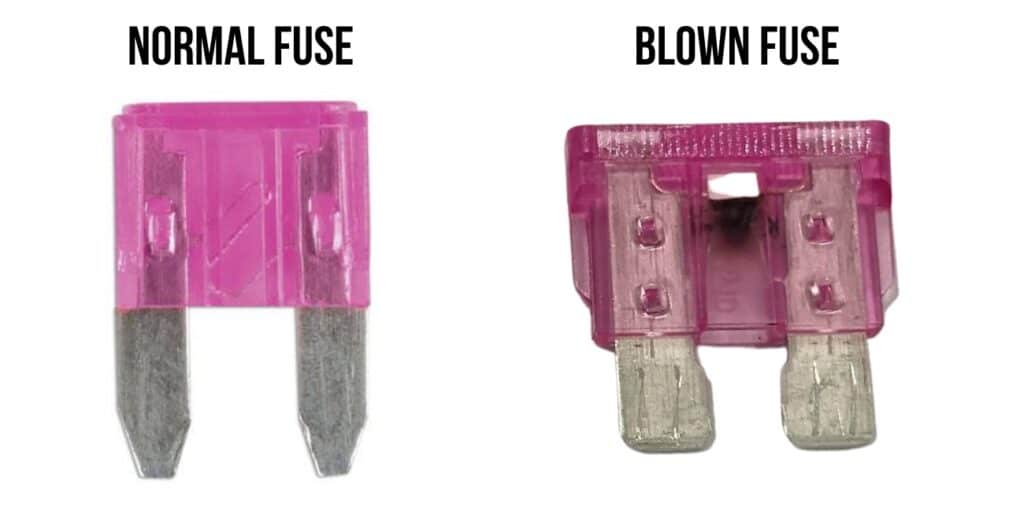When you face a blown furnace fuse, immediate action is more than just advisable—it’s crucial. Merely replacing the fuse or resetting the breaker may seem quick, but it falls short of a lasting solution. A fuse that frequently blows is typically a sign of a deeper issue that demands urgent attention. Identifying and rectifying the underlying cause is imperative to ensure your furnace operates efficiently and safely.
Furnace fuses are essential safety mechanisms, shielding your system from electrical overloads and potential dangers. Such overloads could lead to hazardous electrical fires, notoriously difficult to manage. Therefore, the fuse plays a critical role in preserving the safe functioning of your furnace and preventing potential electrical fires in your home.
It’s important to understand that most modern furnaces, including gas variants, have fuses. Regardless of the type, every furnace requires an electrical connection to operate. Electrical components, such as blower motors and control circuits—even in gas furnaces—depend on this connection. The fuses in furnaces are generally low voltage, often between three amp to five amp.
This guide offers comprehensive insights into furnace fuse issues. We explore the reasons behind a blown fuse and provide a thorough understanding of the steps necessary for replacement and prevention. Our goal is to equip you with all the essential knowledge to tackle this common problem with your furnace.
Where Is the Furnace Fuse Located?
The furnace fuse location varies depending on several factors, including the type of furnace you have (electric or gas) and its make and model. Here’s a more detailed look at where you might find the fuse in different furnace types.
Electric Furnaces
In electric furnaces, the search for the fuse is generally more straightforward. Most commonly, the fuse is located in your home’s main electrical service entrance. This is the central point where your home’s electrical system is managed, and it’s a typical spot for housing furnace fuses. However, this is not the only place to look.

Some electric furnaces might have a separate fuse box dedicated to the furnace’s electrical system. If the fuse isn’t in the main panel, it’s advisable to look for this secondary box, located near the furnace or in another utility area.
Additionally, the heating elements within the electric furnace often have their own set of fuses. These are typically placed in a panel on or inside the furnace housing, designed for easy access during maintenance or inspection.
Gas Furnaces
For gas furnaces, the situation is slightly different. The fuses in a gas furnace are generally located within the furnace housing itself. This is the main part of the furnace where the operational components are situated. However, the exact placement of the furnace fuse box can differ significantly based on your furnace’s make and model.
In some models, the fuse box may be immediately visible upon opening the furnace’s access panel. In others, it might require a bit more searching within the housing.
Due to these variations, it’s highly beneficial to refer to your owner’s manual for specific details about the fuse location in your furnace. The manual can provide precise information tailored to your furnace model, making locating and accessing the fuse much simpler.
How to Tell If a Furnace Fuse Is Blown
Identifying a blown furnace fuse is a crucial step in troubleshooting furnace problems. Most furnace control boards use blade fuses, also common in vehicles, making them a familiar sight to many.
Blade fuses, encased in plastic, feature two metal prongs that plug directly into your furnace’s control board. Their design is relatively simple, making it easy to check their condition. The key to determining if a blade fuse is blown lies in inspecting its central plastic casing.

Here’s a detailed look at how you can tell if such a fuse in your furnace has blown:
Visual Inspection
A visual inspection is the most effective way to determine if a blade fuse has blown. Look closely at the central plastic casing of the fuse. If you notice any burning or discoloration, it clearly indicates that the fuse has blown. This discoloration typically results from the internal element melting due to excessive current.
Disconnected Element
Another sign of a blown fuse is a visible break or disconnection in the filament or wire that runs through the middle of the fuse. If this element is not intact, the fuse has blown and no longer functions.
Lack of Power
Sometimes, you may not need to physically inspect the fuse to know it’s blown. If your furnace lacks power or fails to start, it could be due to a blown fuse. However, these symptoms can also indicate other issues, so it’s always best to confirm by checking the fuse directly.
Safety First: Always ensure the power to the furnace is turned off before you attempt to inspect or replace any fuses. This is crucial to avoid any electrical hazards. If you are unsure about inspecting the fuse yourself or notice any other unusual signs with your furnace, it’s advisable to seek assistance from a professional HVAC technician.
What Causes a Furnace Fuse to Blow?
A blown furnace fuse typically signals deeper problems within your heating system. Identifying and understanding the factors contributing to this issue is crucial in preventing future occurrences.
Let’s delve into the common causes:
1. Dirt and Dust Accumulation
One of the primary reasons for a furnace fuse blowing is the accumulation of dirt and dust. Over time, dust and debris gather in various furnace components, such as filters, motors, and electrical parts. This buildup can restrict airflow and cause overheating. When components overheat, they consume more electricity, potentially causing the fuse to blow as a safeguard.
Regular cleaning and maintenance can substantially lower the risk of fuse issues due to dirt and dust accumulation.
2. Wiring Issues
Wiring problems are another common culprit behind furnace fuse blowouts. These can include:
- Faulty Wiring: Wiring in your furnace can suffer damage or deteriorate over time due to natural wear, rodent damage, or environmental factors. Such faults can lead to short circuits or electrical overloads, resulting in blown fuses.
- Aged Wiring: In older furnaces, the wiring might be aged and incapable of efficiently handling the current electrical load. Old or outdated wiring is more susceptible to overheating and electrical faults.
3. Wear and Tear on Components
Various furnace components, including the blower motor, heating elements, and control board, are subject to wear and tear. This deterioration can cause various electrical issues, like short circuits or increased electrical resistance, triggering a fuse to blow.
Regular inspections are crucial for identifying and replacing worn components before they cause significant issues like a fuse blowout.
What Makes Furnace Fuse Keep Blowing
If you replace a furnace fuse and it blows again immediately, you face a more significant issue that needs urgent attention. A furnace fuse that repeatedly blows signals an ongoing problem within your heating system. Understanding the root causes is essential for addressing and preventing future issues.
Let’s examine the reasons why a furnace fuse might continuously blow:
1. Excessive Strain
An overworked or overloaded furnace often results in the recurrent blowing of the fuse. Overloading can occur in various ways:
- Overuse: Constantly running your furnace or using very high settings for extended periods can place undue strain on the system.
- Inadequate Size: A furnace that is too small for the heating space will have to work harder to maintain the desired temperature, potentially leading to overloads.
2. Clogged Filters
Clogged air filters are a common yet frequently overlooked cause of continuous furnace fuse blowouts. Dirty or blocked filters restrict airflow, forcing the furnace to exert extra effort. This increased strain boosts the electrical load, leading to fuse issues.
Regular inspection and replacement of furnace filters are simple but effective measures to avoid this problem.
3. Incorrect Fuse Wattage
Using a fuse with an inappropriate wattage for your furnace is a common mistake that leads to fuse blowouts. A fuse not rated for your furnace’s electrical load will blow under normal conditions, as it’s unable to handle the required power.
It’s crucial to ensure that any replacement fuse matches the specified wattage for your furnace to prevent repeat occurrences.
4. Faulty Parts
Defective or aging components within your furnace can also cause frequent fuse issues. Critical parts like the blower motor or transformer, crucial for the furnace’s operation, can draw excessive power or cause short circuits when they malfunction or wear out, leading to a blown fuse.
Regular furnace maintenance and timely replacement of these parts are essential for mitigating this problem.
Persistent fuse blowouts in your furnace indicate deeper issues that demand immediate resolution. From excessive strain and clogged filters to incorrect fuse wattage and faulty components, each problem requires a specific solution.
If you’re continually replacing the fuse, consulting a professional HVAC technician for an in-depth inspection and a long-term fix is advisable.
Replacing a Blown Furnace Fuse
Replacing a blown furnace fuse can be a manageable DIY task for many homeowners. Still, it’s also something that can be handled by a professional. Whether you do it yourself or hire a professional, understanding the process and costs involved is important.
Steps for replacing a furnace fuse that blows:
- Turn Off the Power: Safety is paramount. Before you start, turn off the power supply to the furnace. This usually means switching off the breaker in your electrical panel dedicated to the furnace.
- Locate and Inspect the Fuse: Find the fuse within the furnace’s electrical panel. Inspect it for signs of damage, such as discoloration or a broken filament.
- Select the Right Fuse: Choosing a replacement fuse with the correct wattage and size for your furnace is crucial. Using a fuse with the wrong specifications can lead to further problems. The required fuse specifications are typically found in the furnace’s manual or existing fuse.
- Replace the Fuse: Carefully remove the blown fuse and replace it with a new one. Ensure that it fits securely and that there’s no loose connection.
- Test the Furnace: After replacing the fuse, turn the power back on and test if the furnace operates correctly. Observe its functioning for a while to ensure that the issue is resolved.
How much does it cost to replace a blown fuse?
- DIY Approach: If you’re replacing the fuse yourself, the cost is relatively low, primarily the price of the replacement fuse. Fuses are generally inexpensive, typically ranging from $5 to $25, depending on the type and specifications required for your furnace.
- Professional Replacement: Hiring a professional can be more costly but offers the benefit of expert service. The cost can vary depending on your location and the service fee of the technician. Still, it generally ranges from $75 to $150, including the fuse cost and labor.
Replacing a blown furnace fuse can be a straightforward task. Still, doing it safely and with the correct replacement parts is important. While the DIY approach is more cost-effective, hiring a professional provides the advantage of a comprehensive check and peace of mind.
In conclusion, addressing a furnace fuse blow is essential to maintaining your home’s heating system. Whether you opt for a DIY approach or seek professional help, understanding the causes, identifying the signs, and knowing how to replace a blown fuse are crucial.
It’s important to remember that while replacing a fuse might resolve immediate issues, it’s often a symptom of underlying problems. Regular maintenance, timely identification of potential issues, and understanding of your furnace’s requirements can prevent future fuse blowouts and ensure efficient, safe operation. If your furnace fuse keeps blowing, it’s a clear sign that a deeper investigation by a professional HVAC technician may be necessary to safeguard and maintain a comfortable in your home.






